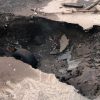
You wake up, it’s dark and you’re lying in a pool. You don’t remember how you got here. You stand up, stretch your aching limbs, walk towards the exit and out into the brilliant sunshine. As your eyes adjust to the light, the world comes slowly into focus – and it is beautiful.
The greens of the open plains contrast with the dark black of Death Mountain, which is streaked with orange lava on the distant horizon. As the sweeping orchestral soundtrack swells, you realise that you can go anywhere and that this is not like any Zelda you’ve played before.
Released on Wii U and Switch in March, The Legend of Zelda: Breath of the Wild (BotW) is the biggest Zelda title ever made. One-and-a-half times the size of open-world trailblazer Skyrim and 12 times the size of Twilight Princess, it provides a vast terrain to explore with barely any restrictions beyond a few hours of subtly enclosed preparation. For many developers, the idea of making a 100+ hour game that’s almost entirely player-led is a terrifying prospect, as the lack of overt structure can be overwhelming and dis-incentivising for the player.
BotW, however, employs a range of quiet, clever techniques designed to help players navigate the environment. Rather than a daunting and intimidating unknown, the world is a series of breadcrumb trails ready to be discovered and followed. This is how it works:
The world in miniature
The first example of Nintendo’s philosophy of gentle guidance is at the very start of the game. When you set out, you are contained within a raised area called the Great Plateau, from which the rest of the world is inaccessible until you earn the paraglider item.
Instead of a conventional tutorial mission, this small region is an intricately designed miniature version of the entire map. It has several enemy encampments to teach you about combat, different climates that introduce you to stat-boosting food and clothing, and four shrines that mirror the four divine beast dungeons, which provide the main body of the challenge later on.
The player is subtly informed about waypoint-setting and quest markers, and pointed towards the end goal – Hyrule Castle. It’s not a tutorial, it’s the whole experience encapsulated into a two-hour mini-adventure.

So BotW tells you that it is a game about exploration and leaves you largely undirected apart from a few interventions from a mysterious old man.
“One of my favourite things about BotW is how totally and gleefully free the experience is,” says Joel Burgess, world director at Ubisoft Toronto, whose past work includes Fallout 4 and Skyrim. “The game has the confidence to trust players to be the stewards of their own experience.”
BotW doesn’t tell players what to do, it shows them how to do what they want to do. Gentle encouragement and correction gives players a reason to keep going as they set self-directed goals (get to Death Mountain or find out what that weird rock formation on top of the cliff is) and figure out how to overcome their own limitations.
“BotW’s level design draws a lot from the idea of the road trip,” says Lena Raine, a level designer at Ubisoft who previously worked on Guild Wars 2. “It often feels like you’re putting away your phone, opening up the paper map, and setting a destination.”
On a road trip, Raine elaborates, destinations are the big cities you know you’ll visit along the way – in the game, these are the main four dungeons. Pit stops are the places you’d get petrol or check the map on a road trip, and in the game, those are the towers, which provide context for the larger world beyond your directed goals.
“And then there are the Korok puzzle tourist traps,” Raine adds, referring to the game’s little environmental puzzles, where players are rewarded with magic beans for, say, putting apples in front of holy shrines. “These represent those little oddities on the side of the road that draw your eye and get you to make an unexpected visit. They don’t take up much time or effort, they don’t add much to the experience other than a brief bit of fun, and there’s always someone that complains that they’re pointless.”
How the world speaks to the player
The Korok seed puzzles teach players to study the landscape, to discover the supernatural within the natural – just as we notice standing stones or crop circles when we go out walking in the countryside.
Most of the scenery in BotW is set dressing, but when we see a single rock standing alone from the rest, or trees appearing in neat, unnatural rows, we immediately take notice because they may represent a puzzle that will reveal one of the valuable seeds. “All of these are challenges to the player, to make them stop in their tracks and solve a mystery,”, says Raine.
The game also guides you through the placement of tall glowing structures like airport runways, lit up to guide you in safely. It’s a deconstruction of the “Ubisoft towers” that force Far Cry, Watch Dogs and Assassin’s Creed players to climb high structures to unlock the map. BotW, however, does not provide waypoint markers.
“BotW doesn’t do anything automatically outside of filling in the terrain on a map. What you discover is up to you to notice; the glow guides your eyes to these important places,” says Raine.

Joel Beardshaw, senior game designer at ustwo games, also describes how Nintendo uses odd little scenic details he calls “Scooby-Doo elements”, such as cracks in the wall or strange doors, which invite experimentation.
“[You can] show the player the reward in plain sight, and make them trace back to a hidden connection,” Beardshaw says. “The connection might be a drop down they did not notice, a bit of foliage they can walk through, or just a windy path between two rocks.”
Beardshaw also admires how the game tempts you along certain routes without ever telling you what to expect.
“BotW often gives players info that they have to keep in their head between two locations,” says Beardshaw. “It may be two patterns where one is missing something, a vantage point [which] reveals something you can’t see when you are there, an imperfect map or text description.”
These are hardly the most subtle threads to pull, but in a world so large, and with so much to do, every successful piece of detective work feels like a reward.
“In Japan, procedures and experiences are thoroughly codified and instructions are painstakingly communicated so that everybody ‘gets it’, and everything runs in a smooth and orderly fashion,” says game designer Jordan Amaro, who has worked with Capcom, Kojima Productions and Nintendo.
“Thus, when it comes to games, it’s no surprise that Japanese designers want players to experience all the possible variations – that’s what they believe is the most enjoyable experience.”
Amaro says that, in Japan, it is considered the designer’s job to guide the player through experience, leading to hand-holding and linearity – something frowned upon in the west.
“Just like Legend of Zelda II, in which roads are always perfectly safe, the roads in Breath of the Wild are where the bulk of that carefully planned and desirable experience is,” says Amaro.

More subtly, Amaro says that success in BotW depends on an important skill in Japanese culture and society: the ability to “read the air”. This means understanding body language, facial expressions and subtle hints, often used to convey information.
“If you can read the air in BotW, you’ll find that the order of the divine beast is subtly signposted: seemingly non-essential yet critical side-quests, recommendations and hearsay from travellers, the location of certain NPCs (the Goron merchant in Lanayru, for example): all these hints are there for you to pick up. Japanese language is often indirect: an allusion is actually a comment, a piece of advice is really a warning. That’s how BotW works: there is a carefully designed and quite linear walkthrough hiding inside this huge world.”
In the later stages of the game when your exploration is driven by curiosity more than narrative, there is what Burgess calls a “consistent language of expectation”.
“When it feels like something ought to be here, it almost always is,” he says, using the example of Korok seeds on top of hills and pillars to illustrate “intuitive” patterns and the expectation of a second, hidden treasure chest in each shrine as a “learned” pattern. It’s not so much that the player has seen something they want to get, but that they know it’ll be waiting when they get there. Intuition and received knowledge go hand-in-hand with exploration and puzzle-solving, and both inform the player’s choices in where to go and what to do next.
At the edge of the world
One test of good open-world design is how the developer deals with “edge cases” – those unpredictable people who don’t quite play the game in the way they’re “meant” to. Sometimes, players just aren’t as fluent in game exploration and conventions as the designer expects.
How does BotW manage this? It provides verticality. “For BotW,” says Raine, “travelling vertically is always your way out. You could get sucked into the endless chain of Korok oddities, finding yourself deep in the muck of a swamp surrounded by lizalfos. But you always know that if you keep climbing up, you’ll eventually be able to gain a vantage toward finding your bearings.”
This is, of course, almost the exact opposite of conventional open-world game design in which cliffs are used to close off the player’s path. In titles like Uncharted and Horizon Zero Dawn only very specific, signposted routes are climbable. BotW does away with that.
“There are now millions of players who have become used to climbing every cliff and mountain range,” says Amaro. “How will they not scoff at the next impassable five-metre overhang they encounter?”
Added to the ease of vertical escape is the fact that you can fast-travel whenever and wherever you want, even mid-battle. This means the player is never truly lost or stuck. The simple rule is: to prepare for potentially limitless edge cases, make your escape mechanics limitless to match.
No such thing as failure
Even more fantastically, all of this subtle teasing is there just as a suggestion. Because BotW has no real direction other than “visit these dungeons, defeat Ganon” (and even those dungeons are optional!) the player can actually do whatever she wants.
“Once I had access to the full world map, I made the decision to avoid the first town the main story quest pointed me towards,” says Burgess. “I began to work my way around the world, pushing in a lazy circle that saw me eventually press into the centre and defeat Ganon after defeating two divine beasts, collecting only two upgrades (one heart, one stamina) and having never discovered how to actually spend a Korok seed (despite having nearly 100 on hand).”
Is it a failure of the game design that Burgess never discovered what to do with Korok seeds? Or is it a genius piece of design because the game allowed him to do it the “wrong” way and have fun anyway? BotW is designed around edge cases at a fundamental level.
The game’s “chemistry engine”, which governs the physical properties of certain objects and how they relate to each other, means that experimentation is allowed and rewarded. If one person wants to kill a monster using a bomb attached to a balloon, fanned in the right direction with a giant leaf, they can. The combination of free will, abundant tools and a robust physical rule set allows you to achieve things in idiosyncratic ways. The system is the story.
There are hundreds of examples of how level design influences and manipulates player choice in BotW. You are, mostly, in charge of your own path and order of doing things, which is why you can run straight to the end boss if you’re feeling brave, or potter about for 130 hours, procrastinating from the main quest like the world’s worst Hero of Time.
“The stroke of genius is to deliver minimal information to the player so that they’re filling the blanks and not completing a checklist,” says Amaro. “The character you’re controlling is just a vessel for your inputs and he doesn’t know any more about this space you’re traversing than you do.”
In Breath of the Wild, the job of the designers is not to hold your hand and guide you around a set path. It is reach out hundreds of hands and leave it up to you which you grab first.
- Legend of Zelda: Breath of the Wild DLC announced – new trials and a hard mode



















































Свежие комментарии